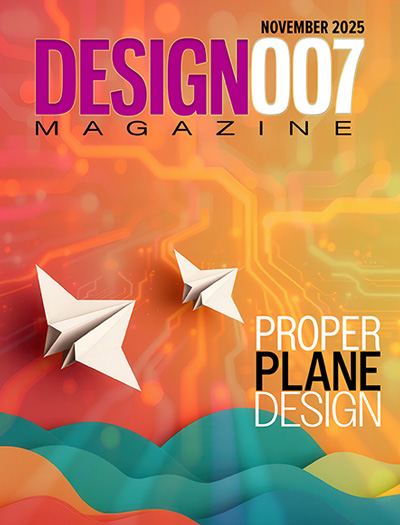-

- News
- Books
Featured Books
- design007 Magazine
Latest Issues
Current Issue
Designing Proper Planes
Without planes, designers would have to create thousands of traces to accomplish the same objectives. Power planes provide low impedance and stable power, and ground planes stabilize reference voltage, improve thermal performance, and help preclude EMI issues.

Power Integrity
Current power demands are increasing, especially with AI, 5G, and EV chips. This month, our experts share “watt’s up” with power integrity, from planning and layout through measurement and manufacturing.

Signal Integrity
If you don’t have signal integrity problems now, you will eventually. This month, our expert contributors share a variety of SI techniques that can help designers avoid ground bounce, crosstalk, parasitic issues, and much more.
- Articles
- Columns
- Links
- Media kit
||| MENU - design007 Magazine
Book Excerpt: The Electronics Industry’s Guide to… The Evolving PCB NPI Process, Chapter 1
September 28, 2022 | I-Connect007 Editorial TeamEstimated reading time: 2 minutes
Chapter 1
How the NPI Process Has Changed and Where We're Going
When forging into unknown territory or exploring new ground, it can help to look at where we’ve been so we can orient ourselves.
Just a few decades ago, electronics manufacturing companies were producing high volumes of few products. The efficiency of electronics manufacturing lines is measured by overall equipment effectiveness (OEE) and total effective equipment performance (TEEP). Back then, this meant optimizing the time it took to build a single board. If the time it took to build one board could be reduced by a few seconds, the savings would be multiplied by the number of boards being built. This could be in the hundreds of thousands or millions of boards, with no changes in the line configuration. If it took a day to change over from one product to another, it didn’t matter because the TEEP/OEE was driven by the time it took to build a board.
For example, consider that it takes 35 seconds to place components on a single board, and I need to make 250 boards. My handling time (the time it takes to load a board into the machine and get it out after) is 10 seconds, then the total time to build the 250 boards will be (35 + 10) • 250 = 11,250 seconds. This equates to about 188 minutes, or approximately three hours. If it takes four hours to changeover—namely reconfigure the line before starting a different PCB—to a new product, my OEE will be less than 50%, considering no other external factors. As the batch size goes down, the changeover time dominates the OEE figure.
In today’s high-mix, low-volume production environments, performance is further enhanced with line efficiency. Line efficiency is the ratio of the number of hours during which a high-volume, pick-and-place machine places parts on the PCB, divided by the number of hours during which the SMT assembly lines are staffed (placement time/staffed time x 100). It is a solid number, simple to obtain, and has great value as a key performance indicator.
With higher product mixes, the number of NPIs being processed increases. Changeovers on the shop-floor line can happen daily or many times a day. This also means the time it takes to process the source design data has increased. This data-processing time is becoming a more important consideration compared to when NPI processing was not a daily task in the lower mix environment. As product mix has gone up, there has been a move from mixed vendor lines focused on ultimate through-put to single vendor lines focused on flexibility and shorter changeovers. There may be more than one pick-and-place vendor brand in the factory, but each line commonly has only one brand now.
Download your free copy today! You can also view other titles in our full library.
We hope you enjoy The Electronics Industry’s Guide to… The Evolving PCB NPI Process.
Testimonial
"The I-Connect007 team is outstanding—kind, responsive, and a true marketing partner. Their design team created fresh, eye-catching ads, and their editorial support polished our content to let our brand shine. Thank you all! "
Sweeney Ng - CEE PCBSuggested Items
MacDermid Alpha Electronics Solutions to Feature an Integrated Materials Platform Engineered for Long-Term Reliability at Productronica
11/12/2025 | MacDermid Alpha Electronics SolutionsEvery advancement in electronics raises expectations for enhanced performance and environmental stewardship. Meeting these challenges demands materials engineered for reliability and developed to support sustainable manufacturing. Industry momentum across connected devices, high-reliability automotive electronics, and rapidly increasing compute density is elevating the role of materials selection as a core driver of long-term system performance.
India Approves $626 Million in Projects to Boost Electronics Parts Output
11/11/2025 | I-Connect007India’s government approved seven projects on Oct. 27, totaling over 55 billion rupees ($626 million), that will expand the domestic production of electronic parts, Reuters reported.
Real Time with... productronica 2025: Pluritec Previews X-ray, Drilling and Wet Processing Automation
11/12/2025 | Real Time with...productronicaNolan Johnson catches up with Maurizio Bonati for a sneak peek at Pluritec's productronica program, and also an update on business in general. Listen to the conversation now and stay tuned for more exclusive coverage of productronica 2025 after the big event next week on realtimewith.com and featured in upcoming I-Connect007 Newsletters.
Discover the Benefits of Inkjet with Electra Polymer at Productronica 2025
11/10/2025 | Electra Polymers LtdElectra Polymers will be showcasing ElectraJet® EMJ110, our advanced low-loss inkjet soldermask, ideal for high-speed and high-frequency PCB applications, at productronica 2025.
Aismalibar, Technosystem Showcase Next-Generation PCB Solutions at productronica 2025
11/05/2025 | AismalibarBENMAYOR S.A., parent company of Aismalibar and Technosystem, will present its latest innovations in thermal management materials and PCB automation systems at Productronica 2025, the world’s leading trade fair for electronics development and production.


